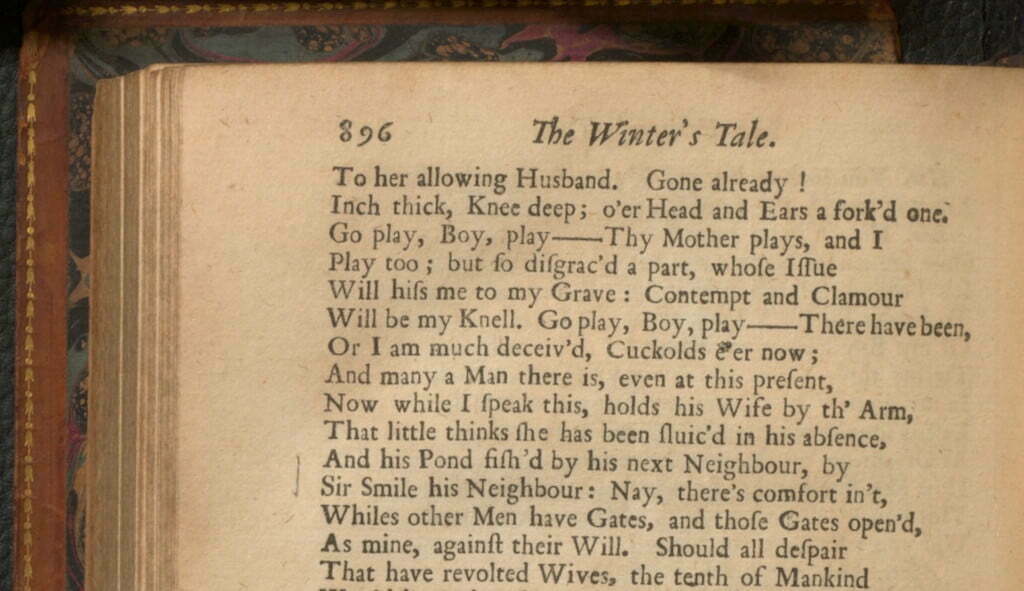Exactly a decade ago, I wrote about how Shakespeare invented the emoticon. Nestled deep in "Winter's Tale" is the first recorded use of the typographic smilie :)
As I discussed, Sir Smile's smile appears in the 1st, 2nd, 3rd, and 4th folios. One hundred years after the 4th folio was printed, the smile vanished. The 1786 edition simply omits it.
At the time, I didn't have access to any other versions between 1685 and 1786 - but I'm delighted to tell you that I've now found one!
The Hathi Trust has a scan of 1709's "The works of Mr. William Shakespear : in six volumes ; adorn'd with cuts / revis'd and corrected, with an account of the life and writings of the author, by N. Rowe, Esq."
Here's there page of Winter's Tale, Act Ⅰ scene ⅱ:
Aha! This version of the play was edited by Nicholas Rowe - later to be the fourth Poet Laureate.
But can we blame him for the missing :)? That's a harder question to answer. While he undoubtedly revised, reorganised, and standardised Shakespeare - he did so from an inaccurate copy. According to the 1911 edition of the Encyclopædia Britannica:
Rowe was the first modern editor of Shakespeare. It is unfortunate that he based his text (6 vols., 1709) on the corrupt Fourth Folio, a course in which he was followed by later editors. We owe to him the preservation of a number of Shakespearian traditions, collected for him at Stratford by Thomas Betterton.
Now this is interesting! We know that some of the Fourth Folios contain the smile - such as this one from the University of Victoria. So which is the corrupt one?
A few years ago, Christie's auctioned off a copy of the Fourth Folio with an interesting provenance:
Tantalizingly, this copy bears the ownership inscription of Charlot Rowe, plausibly Charlotte Rowe (c.1718-1739), the only daughter of Nicholas Rowe (1674-1718). Nicholas Rowe was a dramatist, England's poet laureate, and considered the first professional editor of Shakespeare's plays. His six-volume edition of the plays appeared in 1709. Rowe based his text on that of the most recent comprehensive edition, the Fourth Folio. A Fourth Folio associated personally with Nicholas Rowe and his family, and in such fresh condition, would be a monument in the history of Shakespeare studies.
Even more tantalisingly, the auction contains a high-resolution scan of The Winter's Tale, Act Ⅰ scene ⅱ!
Which, tragically, cuts off just before Sir Smile. :(
Nevertheless, we can compare the scene which is shown.
Here's the "Rowe" scan:

Here's the "Victoria" scan:

Comparing those two scans show them to be virtually identical - even down to the slight misprints on individual letters.
This version of the Folio does over-do the parenthesis. They appear to sometimes be mismatched - "Art thou my Calf?)" for example.
All of which leads me to this conclusion:
- If the Charlot Rowe copy is the same copy used by Nicholas Row - then he is likely the person who removed the smile.
- If Nicholas Rowe used a different copy - then it is likely someone else removed the smile.
So, can anyone find a pre-1709 version of The Winter's Tale which omits Sir Smile's smile?
The investigation continues!


One thought on “Shakespeare's Missing Smile”
This is incredible. Cannot help, but enjoyed reading.
| Reply to original comment on bsky.app
More comments on Mastodon.
What links here from around this blog?